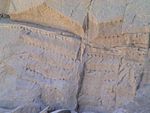- Obelisk making technology in ancient Egypt
-
 Modern Egyptian shows the use of Diorite balls as carving tools for granite, at Aswan
Modern Egyptian shows the use of Diorite balls as carving tools for granite, at Aswan
Obelisk making technology in ancient Egypt is an archaeological matter that is quite well understood today. Ancient Egyptian Obelisks are tapering stone pillars which have a square cross-section, were used for ornamental purposes in temples and had religious or socio-political connotations. They were generally made from granite coming from well-known quarries located near the banks of the Nile, mainly in the region of Aswan. In a quarry in this area, the northern quarry which is now an open-air museum, there is the famous unfinished obelisk of huge proportions. It has been partially carved out of the rock, but its bottom face is still attached to the ground. When it cracked, unsuccessful attempts were made to salvage some of the effort by carving a smaller obelisk from it. It is only crudely carved, marks are left which hint to the technology employed in its extraction.
Contents
The carving procedure
 Tip of the unfinished obelisk with rounded marks that show clearly the use of Diorite balls as carving tools
Tip of the unfinished obelisk with rounded marks that show clearly the use of Diorite balls as carving tools
 Symmetrical marks at the quarry of the unfinished obelisk showing the perforation to be filled with wood in order to detach the stone pieces from the bed
Symmetrical marks at the quarry of the unfinished obelisk showing the perforation to be filled with wood in order to detach the stone pieces from the bed
The carving was done on granite directly on the surface of the stone at the ground, by cutting four sides. It is now known that the tools employed for carving the granite were small balls of diorite. Once the sides were cut off, the stone piece had to be separated from the ground. A series of perforations were made, again using diorite tools. Obelisks made out of softer rock other than granite (i.e. sandstone) were carved with wooden spikes. These perforations were then filled with wood and these wood pieces were water saturated. The small pieces of wood expanded with the humidity breaking the separations between successive perforations and then effectively separating the carved piece from its bed. Many residues left at the rock beds and measuring nearly the size of many famous obelisks (for example the Cleopatra's Needles) are now known to exist at the Unfinished Obelisk open air museum.
The transportation
The obelisks were conveniently made at quarries situated in the banks of the Nile so that the heavy weight structures were easily transported by navigating the river in specially built ships that cruised at the flooding days when the river was deeper.[citation needed] This seems to be a very difficult task to perform but the engineers at the time managed perfectly well without modern machinery or steel cranes.
Raising obelisks
Large obelisks such as the ones erected by Thutmose III were usually lifted by teams of workers, probably laborers or retired farmers. These structures were lifted with thick ropes attached around the pyramid top and base.
See also
External links
- The unfinished obelisk at NOVA
- Obelisks at NOVA
- More about building obelisks at NOVA
- Raising an Obelisk
Ancient Egypt Outline · Index 
Architecture · Art · Burial customs · Chronology · Cuisine · Dynasties · Geography · History · Literature · Mathematics · Medicine · Military · Music · Religion · Pharaohs (list) · People · Language · Sites · Technology · Writing
Egyptology · Egyptologists · Egyptian MuseumPortal · List of major topics Categories:- Archaeological sites in Egypt
- Ancient Egyptian obelisks
Wikimedia Foundation. 2010.
